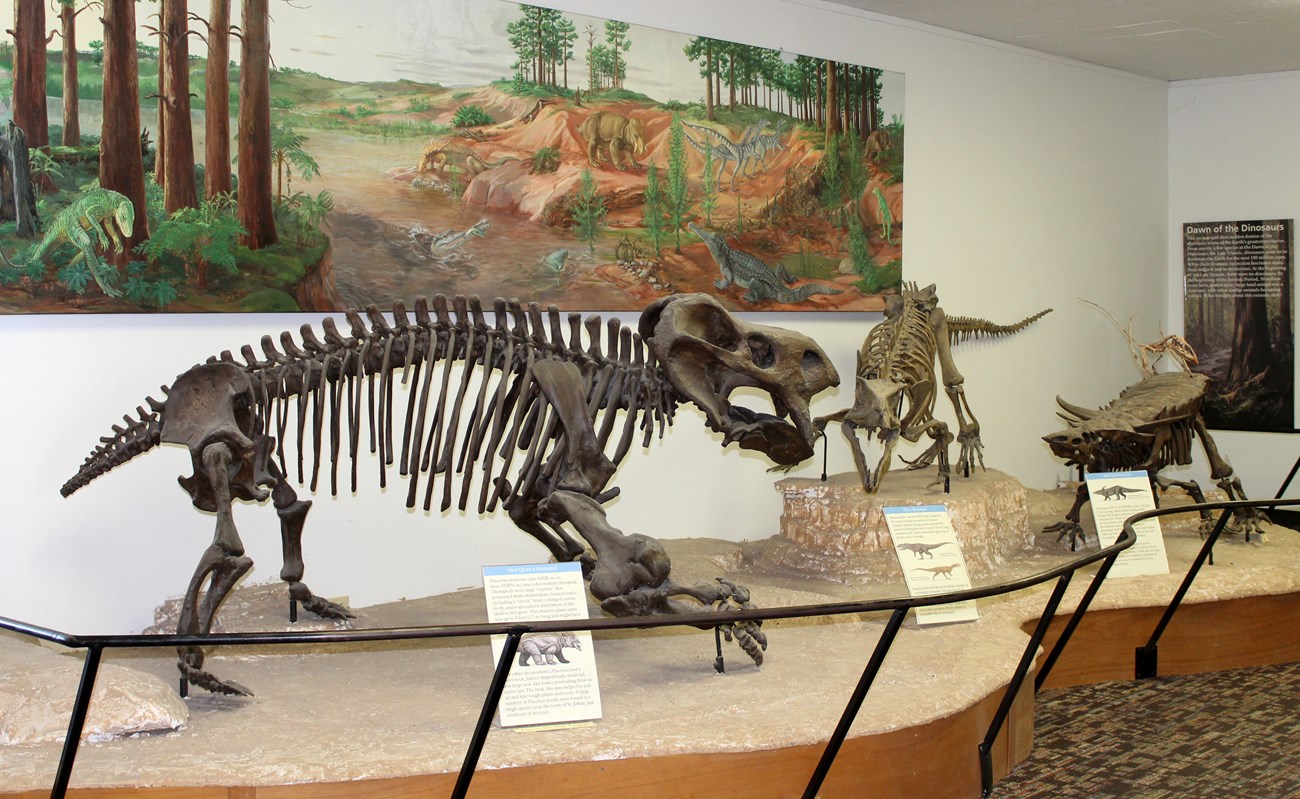
NPS photo by Hallie Larsen
Introducton
The first definite dinosaur fossils are known from the early Late Triassic, about 233 million years ago, although of course it is very unlikely that we would have been lucky enough to have found the actual first dinosaurs. Dinosaurs as a group probably evolved a few million years earlier in the Triassic. Whatever the exact date, the dinosaurs of the Triassic were only a small part of a very unfamiliar land fauna. Because all of Earth’s major landmasses were connected during the Triassic, it was possible for animals to spread easily, so the same groups were found throughout the world.
Amphibians
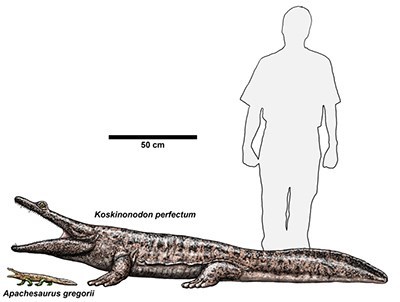
NPS image.
Triassic amphibians were dominated by temnospondyls. Temnospondyls could reach sizes not seen in modern amphibians, such as the 10-foot-long metoposaurs of Petrified Forest National Park. These semiaquatic predators looked something like salamanders with enormous broad, flat, toothy heads. Most temnospondyls went extinct at the end of the Triassic and none survived the Cretaceous.
Aetosaurs
Aetosaurs were crocodile cousins that looked something like the armored dinosaurs that did not have tail clubs. These armored animals were primarily herbivorous and had skeletal features that would have been good for digging up plants. They went extinct at the end of the Triassic.
Phytosaurs
Phytosaurs were distant relatives of crocodiles, but looked very much like them. One obvious difference is that phytosaur nostrils were not at the end of the snout, as in crocodiles, but on top of a short bony ridge in front of the eyes. Otherwise the two groups were so similar that you might call phytosaurs “crocodile mimics” (or crocodiles “phytosaur mimics”, since phytosaurs came first). These semiaquatic predators went extinct at the end of the Triassic.
Crocodile Relatives
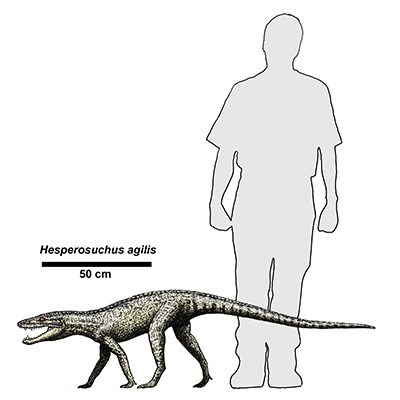
NPS image of drawing by Jeff Martz
The group that includes crocodiles was very diverse during the Triassic. We’ve already met aetosaurs and phytosaurs (although it’s not clear how closely phytosaurs were related to crocodiles). There were also many species of terrestrial crocodile relatives. Some of them were bipedal and looked like large carnivorous dinosaurs (Poposaurus, Postosuchus). Some had fins on their backs (Arizonasaurus). Others looked like ostrich-mimic dinosaurs (Shuvosaurus). The closest relatives to modern crocodiles were small long-legged terrestrial predators that resembled early carnivorous dinosaurs (Hesperosuchus). Most of these groups, except for animals like Hesperosuchus, went extinct at the end of the Triassic.
Other Reptiles
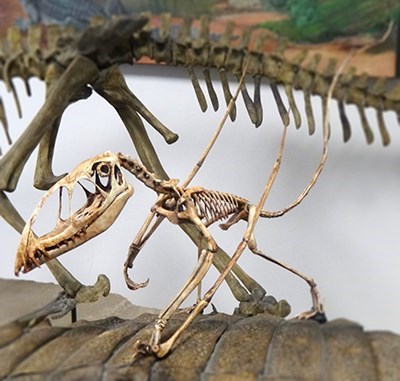
NPS photo.
During the Triassic, reptiles evolved to fill many niches, and took on a wide variety of shapes and sizes. Many of these reptiles went extinct at the end of the Triassic, such as the chameleon-like drepanosaurs, the long-necked tanystropheids, and the placodonts, which looked something like marine turtles with bulbous crushing teeth for eating shellfish. Other groups were much more successful. In the water, the first of the dolphin-like ichthyosaurs and the paddle-finned plesiosaurs evolved. The pterosaurs, the first group of vertebrates to take to the air, also evolved during the Triassic. Pterosaurs and dinosaurs were cousins, and small bipedal animals related to their ancestry flourished briefly during the Triassic.
Mammal Relatives
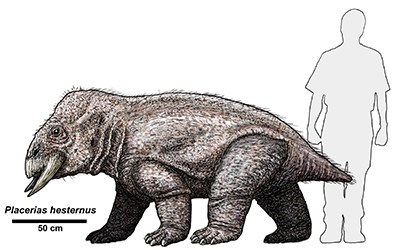
NPS image of drawing by Jeff Martz.
During the preceding Permian Period, so-called “mammal-like reptiles” were a major part of the land fauna, but most of them went extinct at the end of the Permian, leaving open niches that reptiles took over in the Triassic. Some of these mammal relatives continued into the Triassic. One of the most famous of these is Placerias, from the Late Triassic of Arizona, a large quadrupedal herbivore with two thick tusks sticking out of the side of the face. Most of these mammal relatives died out at the end of the Triassic, but certain shrew or rodent-like species survived and gave rise to modern mammals.
Familiar Faces
Calling them “familiar” might be a stretch, because most of the fossil animals were not very similar to their modern relatives, but the earliest fossils of many modern groups of land vertebrates (or their closest relatives) are known from the Triassic. These include frogs, salamanders, turtles, rhynchocephalians (the group including the modern tuatara), lizards, crocodilians, and mammals. Like dinosaurs, most of these precursors were small parts of the land fauna.
Featured Articles
Site Index and Credits
Age of Dinosaurs (2021)
Text by Justin Tweet (AGI). Contributors: Vincent Santucci (GRD), Adam Marsh (PEFO), ReBecca Hunt-Foster (DINO), Don Corrick (BIBE). Project Lead / Web Development, Jim Wood (GRD).
References
-
Tweet, J.S. and V.L. Santucci. 2018. An Inventory of Non-Avian Dinosaurs from National Park Service Areas. in Lucas, S.G. and Sullivan, R.M., (eds.), Fossil Record 6. New Mexico Museum of Natural History and Science Bulletin 79: 703-730. https://irma.nps.gov/DataStore/Reference/Profile/2257153
-
Santucci, V.L., A. Marsh, W. Parker, D. Chure, and D. Corrick, 2018. “Age of Reptiles”: Uncovering the Mesozoic Fossil Record in three Intermountain national parks. IMR Crossroads. Spring 2018, p. 4-11. https://irma.nps.gov/DataStore/Reference/Profile/2253529
Last updated: July 8, 2022
